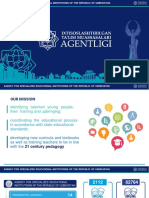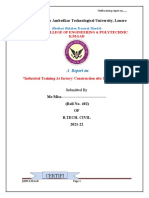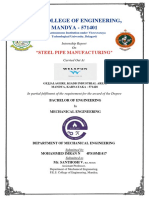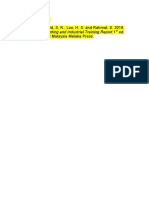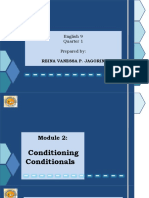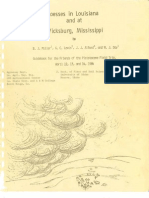Preface: Industrial Training Report
Preface: Industrial Training Report
Uploaded by
Isuru Pasan DasanayakeCopyright:
Available Formats
Preface: Industrial Training Report
Preface: Industrial Training Report
Uploaded by
Isuru Pasan DasanayakeOriginal Title
Copyright
Available Formats
Share this document
Did you find this document useful?
Is this content inappropriate?
Copyright:
Available Formats
Preface: Industrial Training Report
Preface: Industrial Training Report
Uploaded by
Isuru Pasan DasanayakeCopyright:
Available Formats
Industrial Training Report
Preface
Industrial Training module is very important and useful module for the students to improve their
skills and knowledge. I could gain a good knowledge and gather valuable experiences during my
training period. This report is presented based on the training experiences I obtained during 24
weeks training period at three training establishments.
By the first chapter I have given lot of details about the training establishments Ceylon
Electricity Board (CEB) Lanka Electricity Company (LECO) and Sri Lanka Ports Authority
(SLPA) from where I obtained a good training. It includes main functions, organizational
structures, importance to the society and the present performance of all three establishments. I
have included some weaknesses of the establishment and also some suggestions have been given
to improve the performance.
Through the second chapter I have mentioned all the experiences I obtained during my training
period. As I had to undergo training at three establishments I was able to get train at 20 different
places. This chapter includes brief details about that every place. As well as the details about the
work carried out by me during my training period are also included in this chapter.
Ability of all three establishments to provide useful industrial training and suggestions to
improve the training practices is discussed in chapter 3 under Conclusion.
Department of Electrical Engineering Page i
University of Moratuwa
Industrial Training Report
Acknowledgement
First of all I wish to express my gratitude towards to the National Apprentice and Industrial
Training Authority (NAITA) and the Training Division of the University of Moratuwa for
coordinating the training program and providing me the opportunity to obtain my training at
Ceylon Electricity Board(CEB), Lanka Electricity Company(Pvt) Limited(LECO) and Sri lanka
Ports Authority(SLPA).
Then I would like to thank the Training Director of Ceylon Electricity Board
Mr.W.D.Buddhadasa for arranging us a valuable training program which was very helpful me to
gain a good knowledge about electricity generation and transmission in Sri lanka. As well as I
would like to give my praise to all the employees of Ceylon Electricity Board who helped me in
many ways to obtain a good training during that period.
I must also give my gratitude to the Head of the Engineering Division Dr.Narendra de Silva for
providing us a good training when we were at Lanka Electricity Company (Pvt) Limited.
I like to thank the Chief Training Manger of Sri Lanka Ports Authority Mr.K.A.Ansar for
arranging us the training at Ports Authority and Eng.H.B.A.Subhashini for her kind contribution
in making our training schedule of SLPA. And also I would like to grant my special gratitude to
Eng.E.G.S.Dinendra De Silva who dedicated his time to give us a good training when we were at
Jaya Container Terminal.
Finally I would like to thank all people who rendered their kind support to enrich my training
experience.
S.R.Adikaram
070010T
Department of Electrical Engineering
University of Moratuwa.
Department of Electrical Engineering Page ii
University of Moratuwa
Industrial Training Report
Content
Page
Preface i
Acknowledgment ii
Content iii
List of Figures viii
List of Tables ix
List of Annexes x
Chapter 1 – Introduction
1.1 Ceylon Electricity Board (CEB) 1
1.1.1 Introduction 1
1.1.2 Vision 1
1.1.3 Mission 1
1.1.4 Main Functions 1
1.1.4.1 Generation 1
1.1.4.2 Transmission 2
1.1.4.3 Distribution 2
1.1.5 Organizational Structure 2
1.1.6 Usefulness to the Society 2
1.1.7 Weaknesses and Suggestions to improve performance 2
1.2 Lanka Electricity Company (Pvt) Limited (LECO) 3
1.2.1 Introduction 3
1.2.2 Vision 3
1.2.3 Mission 3
1.2.4 Organizational Structure 3
1.2.5 Present Performance 3
1.2.6 Profitability and Usefulness to the society 4
1.2.7 Suggestions to improve performance 4
Department of Electrical Engineering Page iii
University of Moratuwa
Industrial Training Report
1.3 Sri Lanka Ports Authority (SLPA) 5
1.3.1 Introduction 5
1.3.2 Vision 5
1.3.3 Mission 5
1.3.4 Main Functions 5
1.3.5 Organizational Structure 6
1.3.6 Current Facilities and Performances 6
1.3.7 Usefulness to Sri Lanka and Suggestions to improve performance 6
Chapter 2 – Training Experiences
Ceylon Electricity Board
2.1 Protection Development Branch
2.1.1 Introduction 7
2.1.2 Transmission Line Protection Methods 7
2.1.3 Biyagama Receiving Station 8
2.1.4 Protection Monitoring System 8
2.2 Asset Management Hydro Electrical
2.2.1 Introduction 9
2.2.2 Calibrating a Power and Energy Meter 9
2.2.3 Training Experiences 9
2.3 Sapugaskanda Grid Substation
2.3.1 Introduction 10
2.3.2 Commissioning of newly installed power transformer 10
2.3.3 Training Experiences 11
2.4 Generation Planning Branch
2.4.1 Introduction 12
2.4.2 National Demand Forecast 12
2.4.3 WASP Simulation Software 12
2.5 Transmission Planning Branch
2.5.1 Introduction 13
2.5.2 Training Experiences 13
Department of Electrical Engineering Page iv
University of Moratuwa
Industrial Training Report
2.6 Sapugaskanda Diesel Power Station
2.6.1 Introduction 14
2.6.2 Generation Process 14
2.7 Kotmale Hydro Power Station
2.7.1 Introduction 15
2.7.2 Training Experiences 15
2.8 System Control Centre
2.8.1 Introduction 16
2.8.2 Duties and Functions 16
2.8.3 Policy on Power System Operation in CEB 17
2.8.4 Training Experiences 17
Lanka Electricity Company (Pvt) Limited
2.9 Engineering Division
2.9.1 Introduction 18
2.9.2 LECO Network 18
2.9.3 Arial Bundle Conductors (ABC) 19
2.9.4 Geographical Information System (GIS) 19
2.9.5 Other Training Experiences 19
2.10 Kalutara Branch Office
2.10.1 Introduction 20
2.10.2 Customer Billing and Revenue Collection 20
2.10.3 Non Payment Disconnection 21
2.10.4 New Connection and Meter Testing 21
2.10.5 Other Training Experiences 21
2.11 System Operation Division
2.11.1 Introduction 22
2.11.2 Distribution Control Center (DCC) 22
2.11.3 Interruption Scheduling 23
2.11.4 Meter Test Lab 23
Department of Electrical Engineering Page v
University of Moratuwa
Industrial Training Report
2.12 Kalutara Customer Service Center
2.12.1 Introduction 24
2.12.2 Replacing a Pole 24
2.12.3 Shifting a meter and a service line 25
2.12.4 Repairing a broken service line 26
2.12.5 Breakdown Registry 26
2.12.6 Other Training Experiences 26
Sri Lanka Ports Authority
2.13 Electrical Field II
2.13.1 Introduction 27
2.13.2 Domestic Wiring System 27
2.13.3 Circuit Breakers 28
2.13.4 Planning Illumination projects and Selection of Luminaries 28
2.14 Electrical Field I & IV
2.14.1 Introduction 29
2.14.2 Training Experiences 29
2.15 Electrical Field III
2.15.1 Introduction 30
2.15.2 Motor Rewinding 30
2.15.3 UCT Substation 31
2.15.4 Other Training Experiences 31
2.16 Electrical Field V
2.16.1 Introduction 32
2.16.2 Baghdad Substation 32
2.16.3 Underground Cables 32
2.17 Air Conditioner and Refrigerator Repair Workshop
2.17.1 Introduction 33
2.17.2 Air Conditioning Cycle 33
2.17.3 Types of Air Conditioners 34
2.17.4 Other Training Experiences 34
Department of Electrical Engineering Page vi
University of Moratuwa
Industrial Training Report
2.18 Floating Craft Section
2.18.1 Introduction 35
2.18.2 Tug Crafts 35
2.18.3 Pilot Boats 35
2.18.4 Dredger Ships 35
2.19 Telecommunication Section
2.19.1 Introduction 36
2.19.2 Main Distribution Frame (MDF) 36
2.19.3 Telephone Cable Colour Code 36
2.19.4 Pair Gain System 37
2.20 Jaya Container Terminal (JCT)
2.20.1 Introduction 38
2.20.2 Ship to Shore (STS) Gantry Cranes 38
2.20.3 Rubber Tired Gantry Cranes (RTGC) 41
2.20.4 Rail Mounted Gantry Cranes (RMGC) 41
2.20.5 JCT 3 & 4 Substation 41
2.20.6 Colombo Port Expansion Project 42
Chapter 3 – Conclusion 43
Department of Electrical Engineering Page vii
University of Moratuwa
Industrial Training Report
List of Figures
Page
Figure 2.1 Trip Time Characteristic 7
Figure 2.2 Schematic of LECO System 18
Figure 2.3 Meter Test Bench 23
Figure 2.4 Removing the damaged pole 24
Figure 2.5 Attaching the bundle to the pole 25
Figure 2.6 Shifting a meter 25
Figure 2.7 Applying a joint using Climping tool 25
Figure 2.8 Temporary joint 26
Figure 2.9 T-Off connector 26
Figure 2.10 Block diagram of a single phase domestic wiring 27
Figure 2.11 Wiring Diagram of the single phase exhaust fan 29
Figure 2.12 Winding arrangement of the exhaust fan motor 31
Figure 2.13 Cross Sections of Underground cables 32
Figure 2.14 Air Conditioning Cycle Diagram 33
Figure 2.15 The Universal Colour Code of the Twisted Pair Cable 36
Figure 2.16 Block diagram of a Pair Gain System 37
Figure 2.17 Components of an STS crane 38
Figure 2.18 STS Gantry Crane power supply arrangement 40
Department of Electrical Engineering Page viii
University of Moratuwa
Industrial Training Report
List of Tables
Page
Table 2.1 Results of the calibration 9
Table 2.2 Results of the Ratio Test 11
Table 2.3 LECO customers’ average consumption in year 2008 20
Department of Electrical Engineering Page ix
University of Moratuwa
Industrial Training Report
List of Annexes
A1, 1, 1, 4, 2 The power transmission network of CEB
A2, 1, 1, 5 The Organizational Structure of CEB as at March 2009
A3, 1, 2, 4 Management Structure of LECO
A4, 1, 3, 1 General plan of Colombo Port
A5, 1, 3, 5 The organizational structure of Colombo Port according to the Electrical
and Electronics Engineering Division
A6, 2, 1, 3 The single line diagram of the Biyagama Switching Station
A7, 2, 1, 4 A figure of the existing Protection Monitoring System
A8, 2, 5, 1 A schematic representation of the transmission process
A9, 2, 6, 2 The Process Flow Diagram of Sapugaskanda Diesel Power Statoion
A10, 2, 8, 2 The Monthly Rolling Planned Outage Report for the month of May in
2010
A11, 2, 9, 4 Section of a GPS / GIS map
A12, 2, 10, 3 A model of Notice of Disconnection
A13, 2, 11, 2 A copy of a daily outage report received to the DCC
A14, 2, 11, 2 Details and the formulas of system performance measuring indices.
A15, 2, 13, 4 Formulas and factors to decide the selection of luminaries
A16, 2, 20, 1 Daily Container Handling Static report of Port of Colombo in March of
2010
A17, 2, 20, 2 Descriptions of the 14 Portainers in the JCT
A18, 2, 20, 6 A Bird eye view of the proposed Colombo South Harbor and the Cross
section of its Breakwater
Department of Electrical Engineering Page x
University of Moratuwa
You might also like
- Field Trip Report 3Document11 pagesField Trip Report 3Michael BOATEYNo ratings yet
- PIIMA - Presidential School Presentation (26 May - Tashkent - Edu Track)Document11 pagesPIIMA - Presidential School Presentation (26 May - Tashkent - Edu Track)johndavsg8022No ratings yet
- What Are The Advantages and Disadvantages of Radial and Ring Distribution? Radial Distribution SystemDocument5 pagesWhat Are The Advantages and Disadvantages of Radial and Ring Distribution? Radial Distribution SystemIsuru Pasan Dasanayake100% (1)
- Macbeth Essay RubricDocument1 pageMacbeth Essay Rubricapi-455169907100% (1)
- IIESl Membership Guideline PDFDocument60 pagesIIESl Membership Guideline PDFniroshnirosh100% (1)
- 4MT17CS007 Aishwarya K InternshipDocument25 pages4MT17CS007 Aishwarya K InternshipPrakash GNo ratings yet
- Format of The Report For De-2 (A)Document4 pagesFormat of The Report For De-2 (A)Devang ShahNo ratings yet
- Industrial Training ReportDocument42 pagesIndustrial Training ReportShubham SatheNo ratings yet
- Supervised Industrial Training Report Mes (Military Engineering Services)Document78 pagesSupervised Industrial Training Report Mes (Military Engineering Services)Adeel Aslam RajpootNo ratings yet
- Training ReportDocument31 pagesTraining ReportMohamed RuzaithNo ratings yet
- Sand Filter MachineDocument64 pagesSand Filter MachineRamesh Yadav100% (2)
- Sujan Training Report New and FinalDocument41 pagesSujan Training Report New and FinalMaajith MarzookNo ratings yet
- Abrassive Jet Machine Project ReportDocument47 pagesAbrassive Jet Machine Project ReportAb BasitNo ratings yet
- Industrial Training Report PDFDocument33 pagesIndustrial Training Report PDFSulaksha WimalasenaNo ratings yet
- Cad Report Vikash FinalDocument23 pagesCad Report Vikash FinalVikash kumarNo ratings yet
- Gujarat Technological UniversityDocument3 pagesGujarat Technological UniversityDipika GuptaNo ratings yet
- Enviormental Studies Microproject1Document22 pagesEnviormental Studies Microproject1jaya bhutekarNo ratings yet
- Project Stage1 Report FormatDocument11 pagesProject Stage1 Report FormatGauri Virkar100% (1)
- CHGHFFJDocument7 pagesCHGHFFJFirdhaws MohammedNo ratings yet
- Report by VishnuDocument41 pagesReport by VishnupeeyushNo ratings yet
- Digital-Fan-Regulator ProjectDocument31 pagesDigital-Fan-Regulator ProjectSRIDHAR C RNo ratings yet
- Density Based Traffic Control System.: Electrical EngineeringDocument41 pagesDensity Based Traffic Control System.: Electrical Engineeringvijay shindeNo ratings yet
- 8th Sem Final Report FormatDocument12 pages8th Sem Final Report FormatSagar JasaniNo ratings yet
- Internship HarshaDocument15 pagesInternship HarshaPratheek GowdaNo ratings yet
- TEN Micro Project 01Document12 pagesTEN Micro Project 01shubham kesarkarNo ratings yet
- Field Training Report-Sai DabhadeDocument12 pagesField Training Report-Sai DabhadeSheila DhengaleNo ratings yet
- Automated Punching MachineDocument8 pagesAutomated Punching MachineMohamed IbrahemNo ratings yet
- Report AicteDocument19 pagesReport Aicte1MV19ET014 Divya TANo ratings yet
- Railway ProjectDocument51 pagesRailway Projectsanojjose75No ratings yet
- DSR Microprojecct GP 2Document22 pagesDSR Microprojecct GP 2SHUBHAM PANHALKARNo ratings yet
- Prepare Report On Small Scale Industry: Micro - Project ProposalDocument9 pagesPrepare Report On Small Scale Industry: Micro - Project ProposalSachin KakdeNo ratings yet
- RUIDP Phase IV - Presentation FinalDocument15 pagesRUIDP Phase IV - Presentation FinalNarendra AjmeraNo ratings yet
- SUMMER TRAINING REPORT RepairDocument20 pagesSUMMER TRAINING REPORT RepairVedant SharmaNo ratings yet
- Imran Final MprintDocument23 pagesImran Final Mprintvishal vallapureNo ratings yet
- Submerged Flooting TunnelsDocument30 pagesSubmerged Flooting TunnelsSrinivas J100% (1)
- Isa Sunasara & Jigar Barot ("Identification of RCC Element There Mantanance and Repair")Document74 pagesIsa Sunasara & Jigar Barot ("Identification of RCC Element There Mantanance and Repair")Isa SunasaraNo ratings yet
- Presentation On Summer TrainingDocument14 pagesPresentation On Summer TrainingAditya Pratap SinghNo ratings yet
- Utkarsh Industrial Training ReportDocument39 pagesUtkarsh Industrial Training Reportprosperity facilitation100% (1)
- Internship ReportDocument54 pagesInternship ReportDestaye UkumoNo ratings yet
- Civil Engineering Department, Universiti Tenaga Nasional: Ifkar Azmi Bin IbrahimDocument45 pagesCivil Engineering Department, Universiti Tenaga Nasional: Ifkar Azmi Bin IbrahimIfkar AzmiNo ratings yet
- Internship Report FinalDocument35 pagesInternship Report FinalDESSIE FIKIRNo ratings yet
- A Micro Project On: Industrial Components Which Are Produced Through Non Conventional Machining ProcessesDocument26 pagesA Micro Project On: Industrial Components Which Are Produced Through Non Conventional Machining Processesrajnish patilNo ratings yet
- Micro Project: Subject:-Emerging Trend in Mechanical EngineeringDocument18 pagesMicro Project: Subject:-Emerging Trend in Mechanical EngineeringVaibhav PatilNo ratings yet
- MPR Project NEW PROJECT PDFDocument25 pagesMPR Project NEW PROJECT PDFKunal KhatikNo ratings yet
- Final Internship Report For COLLEGEDocument60 pagesFinal Internship Report For COLLEGEManish SinghNo ratings yet
- Kamini Environment Studies Micro ProjectDocument27 pagesKamini Environment Studies Micro ProjectKamini SalunkheNo ratings yet
- Nitesh Yadav PDFDocument67 pagesNitesh Yadav PDFPulkit KaushikNo ratings yet
- Bus Ticket System 12 Avinash and Bibek 1Document35 pagesBus Ticket System 12 Avinash and Bibek 1abinashkumarthakurNo ratings yet
- Ai CSPDocument32 pagesAi CSP20am1a3138No ratings yet
- MINI PROJECT CEGB333 Sem 1 2021Document7 pagesMINI PROJECT CEGB333 Sem 1 2021MAAbuBakarNo ratings yet
- Planning and Design of Parking at MANIT Bhopal (NIT-Bhopal) CampusDocument63 pagesPlanning and Design of Parking at MANIT Bhopal (NIT-Bhopal) CampusNirdosh MatreNo ratings yet
- Industrial Training SejalDocument6 pagesIndustrial Training SejalYojana PatkarNo ratings yet
- A Micro-Project On "Prepare Various Types of Welding Joints (With Metal Components) - Display Them On The WallboardDocument11 pagesA Micro-Project On "Prepare Various Types of Welding Joints (With Metal Components) - Display Them On The WallboardRohit BadguNo ratings yet
- Aadesh Pathare Tom Micro ProjectDocument18 pagesAadesh Pathare Tom Micro ProjectAKASH THORATNo ratings yet
- Industrial Internship Training at Crisp, Bhopal: Submitted By:-Ashutosh YadavDocument15 pagesIndustrial Internship Training at Crisp, Bhopal: Submitted By:-Ashutosh YadavAshutosh yadavNo ratings yet
- Technical Seminar Ashish WanveDocument26 pagesTechnical Seminar Ashish WanvecasaNo ratings yet
- Class 11 Civil Engineering OjtDocument4 pagesClass 11 Civil Engineering OjtBipin Belbase0% (1)
- Industrial Training: THE Project ReportDocument50 pagesIndustrial Training: THE Project Reportsuraj gholapNo ratings yet
- Major Training ReportDocument14 pagesMajor Training ReportAli AbnairNo ratings yet
- Acropolis Institute of Technology & Research, IndoreDocument19 pagesAcropolis Institute of Technology & Research, IndoreRrr320No ratings yet
- MRS-CE6 Details of Various - Types of The Agencies Working For Repair and Maintenance of - StructureDocument11 pagesMRS-CE6 Details of Various - Types of The Agencies Working For Repair and Maintenance of - StructureOmkar MohiteNo ratings yet
- Format For Industrial Training Report0 PDFDocument64 pagesFormat For Industrial Training Report0 PDFashawishNo ratings yet
- Vishal A Patil Report NewDocument53 pagesVishal A Patil Report Newmalikavita731No ratings yet
- Wind Design Example Wind Resorce Assesment Assesment: Project LocationDocument2 pagesWind Design Example Wind Resorce Assesment Assesment: Project LocationIsuru Pasan DasanayakeNo ratings yet
- Wind Design Example Wind Resorce Assesment Assesment: Project LocationDocument2 pagesWind Design Example Wind Resorce Assesment Assesment: Project LocationIsuru Pasan DasanayakeNo ratings yet
- Chopper Control DC Drive - 090075mDocument8 pagesChopper Control DC Drive - 090075mIsuru Pasan Dasanayake100% (1)
- Thyristor Switch Operation 090075MDocument6 pagesThyristor Switch Operation 090075MIsuru Pasan Dasanayake100% (1)
- V.I.P. Dasanayake - Computer SystemDocument12 pagesV.I.P. Dasanayake - Computer SystemIsuru Pasan Dasanayake100% (1)
- V.I.P. Dasanayake Capacitance - 2Document6 pagesV.I.P. Dasanayake Capacitance - 2Isuru Pasan DasanayakeNo ratings yet
- V.I.P. Dasanayake CapacitanceDocument5 pagesV.I.P. Dasanayake CapacitanceIsuru Pasan Dasanayake100% (1)
- Lec5 Robot SensorsDocument6 pagesLec5 Robot SensorsIsuru Pasan DasanayakeNo ratings yet
- V.I.P. Dasanayake Mechanical Design of Overhead Transmission LinesDocument4 pagesV.I.P. Dasanayake Mechanical Design of Overhead Transmission LinesIsuru Pasan Dasanayake100% (1)
- Motor Control: Case Study: MIT Handy BoardDocument6 pagesMotor Control: Case Study: MIT Handy BoardIsuru Pasan DasanayakeNo ratings yet
- Practical Schedule v6Document1 pagePractical Schedule v6Isuru Pasan DasanayakeNo ratings yet
- Test On A Single Phase Transformer: Ranasinghe R.A.D.P. Rathnayaka R.M.C. Wijethilaka D.T.B. Wikramaarachchi G.TDocument5 pagesTest On A Single Phase Transformer: Ranasinghe R.A.D.P. Rathnayaka R.M.C. Wijethilaka D.T.B. Wikramaarachchi G.TIsuru Pasan DasanayakeNo ratings yet
- Lec6 MobileRobotControlDocument5 pagesLec6 MobileRobotControlIsuru Pasan DasanayakeNo ratings yet
- Submission To The Queensland Competition Authority (QCA) : Electricity Distribution: Ring Fencing GuidelinesDocument7 pagesSubmission To The Queensland Competition Authority (QCA) : Electricity Distribution: Ring Fencing GuidelinesIsuru Pasan DasanayakeNo ratings yet
- Single Phase TransformerDocument13 pagesSingle Phase TransformerIsuru Pasan DasanayakeNo ratings yet
- Test On A Single Phase TransformerDocument4 pagesTest On A Single Phase TransformerIsuru Pasan DasanayakeNo ratings yet
- Rating of MCBsDocument4 pagesRating of MCBsIsuru Pasan DasanayakeNo ratings yet
- 2.1 Protection Development Branch: Industrial Training ReportDocument11 pages2.1 Protection Development Branch: Industrial Training ReportIsuru Pasan DasanayakeNo ratings yet
- 1.1 Ceylon Electricity Board (CEB) : Industrial Training ReportDocument6 pages1.1 Ceylon Electricity Board (CEB) : Industrial Training ReportIsuru Pasan DasanayakeNo ratings yet
- CoverDocument1 pageCoverIsuru Pasan DasanayakeNo ratings yet
- Ceylon Electricity Board Lanka Electricity Company Sri Lanka Ports AuthorityDocument5 pagesCeylon Electricity Board Lanka Electricity Company Sri Lanka Ports AuthorityIsuru Pasan DasanayakeNo ratings yet
- References: WWW - Ceb.lk WWW - Leco.lk WWW - Slpa.lk CEB Static Digest 2009 WWW - Npa.gov - LK WWW - Mope.gov - LKDocument2 pagesReferences: WWW - Ceb.lk WWW - Leco.lk WWW - Slpa.lk CEB Static Digest 2009 WWW - Npa.gov - LK WWW - Mope.gov - LKIsuru Pasan DasanayakeNo ratings yet
- My ConclusionDocument2 pagesMy ConclusionIsuru Pasan DasanayakeNo ratings yet
- 2.9 Engineering Division: Industrial Training ReportDocument9 pages2.9 Engineering Division: Industrial Training ReportIsuru Pasan DasanayakeNo ratings yet
- 2.13 Electrical Field II: Industrial Training ReportDocument16 pages2.13 Electrical Field II: Industrial Training ReportIsuru Pasan DasanayakeNo ratings yet
- English PortDocument14 pagesEnglish PortsanikaNo ratings yet
- Diameter Routing: Use Case GuideDocument14 pagesDiameter Routing: Use Case Guidemonel_24671100% (1)
- Grade 9 English ConditionalsDocument31 pagesGrade 9 English ConditionalsRiz Ann Joy CasumpangNo ratings yet
- DS82 CompleteDocument6 pagesDS82 CompleteBambang WijanarkoNo ratings yet
- 1984 Louisiana Loess Fieldtrip GuidebookDocument139 pages1984 Louisiana Loess Fieldtrip Guidebooketchplain100% (2)
- Advanced SQL PuzzlesDocument91 pagesAdvanced SQL PuzzlesArindam MitraNo ratings yet
- Geological Survey of Great Britain - L The Country Around Holmfirth and GlossopDocument233 pagesGeological Survey of Great Britain - L The Country Around Holmfirth and GlossopCraig BurtonNo ratings yet
- Steam Turbine Basic Training Module 1 1Document36 pagesSteam Turbine Basic Training Module 1 1Shams TabrezNo ratings yet
- A-1 Bca 101Document2 pagesA-1 Bca 101Lovepreet singhNo ratings yet
- Analytical Method For The Traffic Flow ModelDocument8 pagesAnalytical Method For The Traffic Flow Modelhkabir_juNo ratings yet
- MSDS Chisel Paste - EpirocDocument10 pagesMSDS Chisel Paste - Epirocdwinanda fortuna warmanNo ratings yet
- Saudi Arabian Oil Company: SECTION 13320 Programmable Logic ControllersDocument8 pagesSaudi Arabian Oil Company: SECTION 13320 Programmable Logic ControllersMECHKARTHIKRAJNo ratings yet
- PDLC ANexureDocument9 pagesPDLC ANexurePrakashNo ratings yet
- TechnicalReference DoIPDocument64 pagesTechnicalReference DoIPamr.abdelrahim22No ratings yet
- NBesinovic PHD ThesisDocument249 pagesNBesinovic PHD ThesisTherill FakNo ratings yet
- Concept PaperDocument4 pagesConcept PaperSean Lei Gordula TaborNo ratings yet
- 11 BibiographyDocument9 pages11 Bibiographyswarnika singhNo ratings yet
- CIR Vs DLSUDocument1 pageCIR Vs DLSUKim CajucomNo ratings yet
- Pages From Neuroanatomy Through Clinical Cases (2010) (2nd Ed.) - Inconnu (E)Document2 pagesPages From Neuroanatomy Through Clinical Cases (2010) (2nd Ed.) - Inconnu (E)Abdelhamid Ben SelmaNo ratings yet
- Nursing Informatics: Connecting Technology and Patient Care (First Edition)Document21 pagesNursing Informatics: Connecting Technology and Patient Care (First Edition)Praveen LoniNo ratings yet
- Nature and Scope of Operations ManagementDocument2 pagesNature and Scope of Operations ManagementSathya GaneshNo ratings yet
- Notes On Special Penal Laws by Prof. Ramel MuriaDocument5 pagesNotes On Special Penal Laws by Prof. Ramel MuriaTugs Victor de GuzmanNo ratings yet
- Break Even New2Document39 pagesBreak Even New2thomasNo ratings yet
- Nature and Scope of ResearchDocument13 pagesNature and Scope of ResearchAmen AbrahamNo ratings yet
- Mick McGuire Value Investing Congress Presentation Marcato Capital ManagementDocument70 pagesMick McGuire Value Investing Congress Presentation Marcato Capital ManagementscottleeyNo ratings yet
- 1 Restocking and Grow-Out of Abalone, Taggat Norte MPADocument32 pages1 Restocking and Grow-Out of Abalone, Taggat Norte MPAbeilla swanNo ratings yet
- Reading Sample: "Commerce" Index The AuthorsDocument26 pagesReading Sample: "Commerce" Index The AuthorsSoumak BanerjeeNo ratings yet
- Yamaha Tt600 84 Parts Catalog Eng by Mosue PDFDocument39 pagesYamaha Tt600 84 Parts Catalog Eng by Mosue PDFMiroslaw Gabalix GabalisNo ratings yet

